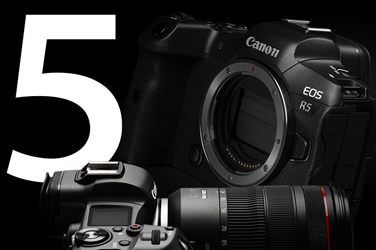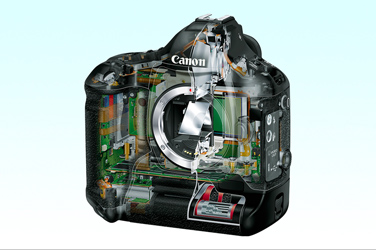Technology in ProductsMirrorless Cameras
Compact, Lightweight, and High Image Quality.
Mirrorless Cameras Open up a New World of Expressive Potential
Mirrorless cameras require no mirrors to reflect light and therefore no optical viewfinder mechanism, making them more compact and lightweight than single-lens reflex (SLR) cameras. Mirrorless cameras can take advantage of all of the technological innovations of digital SLR cameras, such as lens, CMOS sensor and image processing technologies, so they have tremendous potential for further future advancement.
December 23, 2021

How mirrorless cameras work
Mirrorless cameras comprise four main mechanisms.
(1) Lenses
Light reflected by the photo subject passes through the lenses and into the camera.
(2) Image sensor
The light reaches an image sensor, which converts it into a digital signal.
(3) Image processor
The image processor converts the digital signal into image data
(4) Viewfinder/LCD monitor
The image data is displayed in the viewfinder or on an LCD monitor, allowing the photographer to check the image.
↓
The photographer checks the image, adjusts the amount of light, brightness, angle and other conditions before pushing the shutter button to save the image data to storage media.
Read More
Canon's full-frame mirrorless camera technology (EOS R System)

Canon has a wide lineup of mirrorless cameras, from entry-level models that can be enjoyed by beginners to models that provide new expressive possibilities to professional photographers. Different products offer different functions and levels of performance to meet the needs of their respective target users, so Canon's mirrorless cameras require a wide range of technologies.
The EOS R System is an imaging system designed to take the speed, comfort and high image quality of mirrorless cameras to a higher level.
Features of the EOS R System
Large-diameter mount

The mount of an interchangeable-lens camera is the mechanism that connects the lenses to the camera body.
The RF mount used in Canon's EOS R System has a large mount inner diameter of 54 mm, like that of the EF mount*. It is designed to accommodate lenses with all types of characteristics, such as large aperture f/1.0 lenses, high-image-quality lenses, high-magnification lenses and compact lenses. The mount diameter was decided after holistically considering factors such as resulting camera size, ease of use, sturdiness and reliability, while also taking into consideration the mount’s future potential.
* Since its launch in 1987, the EF mount has been used in constantly evolving autofocus SLR cameras with interchangeable lenses.
Short back focus

Interchangeable lenses comprise multiple lens elements. The distance between the rear element (the element in the lens that is closest to the camera body when attached) and the sensor is known as the back focus.

The EOS R System has a short back focus. This allows for optical design that produces higher image quality by placing the lens closer to the image plane as well as greater freedom in optical design, such as designs that prioritize compactness for wide-angle and standard lenses.
Mount communication system
The mount isn't merely a mechanism for physically connecting the lens to the camera. It also coveys various information between them.
Canon's EOS R System uses a new mount communication system, in which lens-specific information such as optical information and optical correction data is stored in the lens, not in the camera. This system instantaneously transmits large amounts of data between the lens and the camera body, making possible high-speed communication and nearly real-time communication commands possible. This contributes to better camera stabilization and offers improved operability through such features as real-time display of subject distance information.
Image sensor technology

For both mirrorless and SLR cameras, image sensor performance is vital to camera performance. Two of the most important properties of image sensors are high resolution and high sensitivity. High resolution sensors can render fine details in subjects. High sensitivity allows the sensors to create noise-free images even in low light conditions.
Canon uses its proprietary technologies to develop and manufacture image sensors in-house.
These sensors are notable for their high resolution and exceptional sensitivity. The newly developed full-frame CMOS sensor, used in the EOS R5 that was launched in July 2020, has a high resolution of roughly 45 megapixels and high sensitivity, with a native ISO of up to 51200 (equivalent to an extended ISO of 102400).
Image processor technology
The image processor is responsible for generating camera images. This semiconductor chip is known as the brains of the camera.
Canon began development of the its DIGIC image processors in 2002, and has since achieved breakthrough after breakthrough, improving performance that has culminated in the latest iteration—the DIGIC X.

Broadly speaking, image processors perform the following two main functions:
• Imaging -- capturing the data that comes into the sensor
• Recording -- recording the captured subject as a high-quality image
An example of this is the DIGIC X used in EOS R5 cameras. It performs high speed signal processing, enabling one of the features of the EOS R5: high-speed continuous shooting of approximately 45 megapixels at rates up to 20 frames per second (when using the electronic shutter).
To achieve the speed, comfort and high image quality that are the hallmarks of Canon mirrorless cameras, it is vital that the lens, sensor, and engine technologies work together as one. Canon develops these key technologies in-house, making the EOS R System one of Canon's greatest strengths. However, it's not enough for any single one to stand out. Canon is steadily advancing all three technologies to further expand its imaging range.






